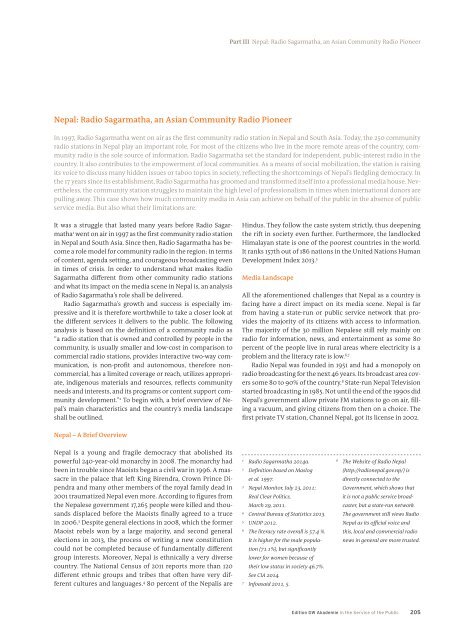edition-dw-akademie-in-the-service-of-the-public-functions-and-transformation-of-media-in-developing-countries-pdf
edition-dw-akademie-in-the-service-of-the-public-functions-and-transformation-of-media-in-developing-countries-pdf
edition-dw-akademie-in-the-service-of-the-public-functions-and-transformation-of-media-in-developing-countries-pdf
You also want an ePaper? Increase the reach of your titles
YUMPU automatically turns print PDFs into web optimized ePapers that Google loves.
Part III Nepal: Radio Sagarmatha, an Asian Community Radio PioneerNepal: Radio Sagarmatha, an Asian Community Radio PioneerIn 1997, Radio Sagarmatha went on air as <strong>the</strong> first community radio station <strong>in</strong> Nepal <strong>and</strong> South Asia. Today, <strong>the</strong> 250 communityradio stations <strong>in</strong> Nepal play an important role. For most <strong>of</strong> <strong>the</strong> citizens who live <strong>in</strong> <strong>the</strong> more remote areas <strong>of</strong> <strong>the</strong> country, communityradio is <strong>the</strong> sole source <strong>of</strong> <strong>in</strong>formation. Radio Sagarmatha set <strong>the</strong> st<strong>and</strong>ard for <strong>in</strong>dependent, <strong>public</strong>-<strong>in</strong>terest radio <strong>in</strong> <strong>the</strong>country. It also contributes to <strong>the</strong> empowerment <strong>of</strong> local communities. As a means <strong>of</strong> social mobilization, <strong>the</strong> station is rais<strong>in</strong>gits voice to discuss many hidden issues or taboo topics <strong>in</strong> society, reflect<strong>in</strong>g <strong>the</strong> shortcom<strong>in</strong>gs <strong>of</strong> Nepal’s fledgl<strong>in</strong>g democracy. In<strong>the</strong> 17 years s<strong>in</strong>ce its establishment, Radio Sagarmatha has groomed <strong>and</strong> transformed itself <strong>in</strong>to a pr<strong>of</strong>essional <strong>media</strong> house. Never<strong>the</strong>less,<strong>the</strong> community station struggles to ma<strong>in</strong>ta<strong>in</strong> <strong>the</strong> high level <strong>of</strong> pr<strong>of</strong>essionalism <strong>in</strong> times when <strong>in</strong>ternational donors arepull<strong>in</strong>g away. This case shows how much community <strong>media</strong> <strong>in</strong> Asia can achieve on behalf <strong>of</strong> <strong>the</strong> <strong>public</strong> <strong>in</strong> <strong>the</strong> absence <strong>of</strong> <strong>public</strong><strong>service</strong> <strong>media</strong>. But also what <strong>the</strong>ir limitations are.It was a struggle that lasted many years before Radio Sagarmatha1 went on air <strong>in</strong> 1997 as <strong>the</strong> first community radio station<strong>in</strong> Nepal <strong>and</strong> South Asia. S<strong>in</strong>ce <strong>the</strong>n, Radio Sagarmatha has becomea role model for community radio <strong>in</strong> <strong>the</strong> region: <strong>in</strong> terms<strong>of</strong> content, agenda sett<strong>in</strong>g, <strong>and</strong> courageous broadcast<strong>in</strong>g even<strong>in</strong> times <strong>of</strong> crisis. In order to underst<strong>and</strong> what makes RadioSagarmatha different from o<strong>the</strong>r community radio stations<strong>and</strong> what its impact on <strong>the</strong> <strong>media</strong> scene <strong>in</strong> Nepal is, an analysis<strong>of</strong> Radio Sagarmatha’s role shall be delivered.Radio Sagarmatha’s growth <strong>and</strong> success is especially impressive<strong>and</strong> it is <strong>the</strong>refore worthwhile to take a closer look at<strong>the</strong> different <strong>service</strong>s it delivers to <strong>the</strong> <strong>public</strong>. The follow<strong>in</strong>ganalysis is based on <strong>the</strong> def<strong>in</strong>ition <strong>of</strong> a community radio as“a radio station that is owned <strong>and</strong> controlled by people <strong>in</strong> <strong>the</strong>community, is usually smaller <strong>and</strong> low-cost <strong>in</strong> comparison tocommercial radio stations, provides <strong>in</strong>teractive two-way communication,is non-pr<strong>of</strong>it <strong>and</strong> autonomous, <strong>the</strong>refore noncommercial,has a limited coverage or reach, utilizes appropriate,<strong>in</strong>digenous materials <strong>and</strong> resources, reflects communityneeds <strong>and</strong> <strong>in</strong>terests, <strong>and</strong> its programs or content support communitydevelopment.” 2 To beg<strong>in</strong> with, a brief overview <strong>of</strong> Nepal’sma<strong>in</strong> characteristics <strong>and</strong> <strong>the</strong> country’s <strong>media</strong> l<strong>and</strong>scapeshall be outl<strong>in</strong>ed.H<strong>in</strong>dus. They follow <strong>the</strong> caste system strictly, thus deepen<strong>in</strong>g<strong>the</strong> rift <strong>in</strong> society even fur<strong>the</strong>r. Fur<strong>the</strong>rmore, <strong>the</strong> l<strong>and</strong>lockedHimalayan state is one <strong>of</strong> <strong>the</strong> poorest <strong>countries</strong> <strong>in</strong> <strong>the</strong> world.It ranks 157th out <strong>of</strong> 186 nations <strong>in</strong> <strong>the</strong> United Nations HumanDevelopment Index 2013. 5Media L<strong>and</strong>scapeAll <strong>the</strong> aforementioned challenges that Nepal as a country isfac<strong>in</strong>g have a direct impact on its <strong>media</strong> scene. Nepal is farfrom hav<strong>in</strong>g a state-run or <strong>public</strong> <strong>service</strong> network that provides<strong>the</strong> majority <strong>of</strong> its citizens with access to <strong>in</strong>formation.The majority <strong>of</strong> <strong>the</strong> 30 million Nepalese still rely ma<strong>in</strong>ly onradio for <strong>in</strong>formation, news, <strong>and</strong> enterta<strong>in</strong>ment as some 80percent <strong>of</strong> <strong>the</strong> people live <strong>in</strong> rural areas where electricity is aproblem <strong>and</strong> <strong>the</strong> literacy rate is low. 6,7Radio Nepal was founded <strong>in</strong> 1951 <strong>and</strong> had a monopoly onradio broadcast<strong>in</strong>g for <strong>the</strong> next 46 years. Its broadcast area coverssome 80 to 90% <strong>of</strong> <strong>the</strong> country. 8 State-run Nepal Televisionstarted broadcast<strong>in</strong>g <strong>in</strong> 1985. Not until <strong>the</strong> end <strong>of</strong> <strong>the</strong> 1990s didNepal’s government allow private FM stations to go on air, fill<strong>in</strong>ga vacuum, <strong>and</strong> giv<strong>in</strong>g citizens from <strong>the</strong>n on a choice. Thefirst private TV station, Channel Nepal, got its license <strong>in</strong> 2002.Nepal – A Brief OverviewNepal is a young <strong>and</strong> fragile democracy that abolished itspowerful 240-year-old monarchy <strong>in</strong> 2008. The monarchy hadbeen <strong>in</strong> trouble s<strong>in</strong>ce Maoists began a civil war <strong>in</strong> 1996. A massacre<strong>in</strong> <strong>the</strong> palace that left K<strong>in</strong>g Birendra, Crown Pr<strong>in</strong>ce Dipendra<strong>and</strong> many o<strong>the</strong>r members <strong>of</strong> <strong>the</strong> royal family dead <strong>in</strong>2001 traumatized Nepal even more. Accord<strong>in</strong>g to figures from<strong>the</strong> Nepalese government 17,265 people were killed <strong>and</strong> thous<strong>and</strong>sdisplaced before <strong>the</strong> Maoists f<strong>in</strong>ally agreed to a truce<strong>in</strong> 2006. 3 Despite general elections <strong>in</strong> 2008, which <strong>the</strong> formerMaoist rebels won by a large majority, <strong>and</strong> second generalelections <strong>in</strong> 2013, <strong>the</strong> process <strong>of</strong> writ<strong>in</strong>g a new constitutioncould not be completed because <strong>of</strong> fundamentally differentgroup <strong>in</strong>terests. Moreover, Nepal is ethnically a very diversecountry. The National Census <strong>of</strong> 2011 reports more than 120different ethnic groups <strong>and</strong> tribes that <strong>of</strong>ten have very differentcultures <strong>and</strong> languages. 4 80 percent <strong>of</strong> <strong>the</strong> Nepalis are1Radio Sagarmatha 2014a.2Def<strong>in</strong>ition based on Masloget al. 1997.3Nepal Monitor, July 23, 2011;Real Clear Politics,March 29, 2011.4Central Bureau <strong>of</strong> Statistics 2013.5UNDP 2012.6The literacy rate overall is 57.4 %.It is higher for <strong>the</strong> male population(71.1%), but significantlylower for women because <strong>of</strong><strong>the</strong>ir low status <strong>in</strong> society 46.7%.See CIA 2014.7Infoasaid 2011, 5.8The Website <strong>of</strong> Radio Nepal(http://radionepal.gov.np/) isdirectly connected to <strong>the</strong>Government, which shows thatit is not a <strong>public</strong> <strong>service</strong> broadcaster,but a state-run network.The government still views RadioNepal as its <strong>of</strong>ficial voice <strong>and</strong>this, local <strong>and</strong> commercial radionews <strong>in</strong> general are more trusted.Edition DW Akademie In <strong>the</strong> Service <strong>of</strong> <strong>the</strong> Public 205


